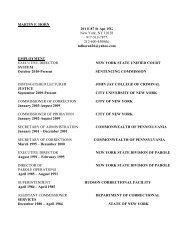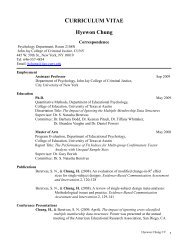Bulletin - John Jay College Of Criminal Justice - CUNY
Bulletin - John Jay College Of Criminal Justice - CUNY
Bulletin - John Jay College Of Criminal Justice - CUNY
You also want an ePaper? Increase the reach of your titles
YUMPU automatically turns print PDFs into web optimized ePapers that Google loves.
Courses <strong>Of</strong>fered<br />
SOC 215 Social Control and Gender: Women in<br />
American Society<br />
3 hours, 3 credits<br />
The effects of various systems of social control on women in<br />
American society. The systematic impact of race, ethnicity, informal<br />
and formal sources of social control of women, ranging from<br />
traditional family sex roles to the treatment of women by courts and<br />
prisons, health care institutions and schools. Examination of<br />
organized efforts by women to change both their social roles and<br />
organized institutions.<br />
Prerequisites: ENG 101 and one of the following: SOC 101, PSY<br />
101 or ANT 101<br />
SOC 216 Probation and Parole: Principles and<br />
Practices<br />
3 hours, 3 credits<br />
Administrative organization and management in the probation and<br />
parole systems. Recruitment, training, assignment and supervision of<br />
probation/parole officers.<br />
Prerequisites: ENG 101 and SOC 101<br />
SOC 222 Sociology of Mass Communication<br />
3 hours, 3 credits<br />
Special emphasis will be placed on the relationship between mass<br />
communications and the criminal justice system. This course will<br />
focus on the rise of mass media, its institutionalization and its<br />
socioeconomic context. Students will utilize techniques of "content<br />
analysis" to assess the image of the police, courts, criminals, prisons,<br />
etc., as presented in the media. The social-psychological process<br />
through which such messages shape and influence public attitudes<br />
will be explored. A highlight of this course will be several in-depth<br />
interviews with distinguished members of the mass media and<br />
criminal justice communities.<br />
Prerequisites: ENG 101 and SOC 101<br />
SOC 224 Death, Dying and Society: A Life Crises<br />
Management Issue<br />
(Same course as ANT 224, PHI 224 and PSY 224)<br />
3 hours, 3 credits<br />
Death and dying will be viewed from the perspectives of a variety of<br />
academic disciplines and applied fields. The course will deal with the<br />
dying process: the different cultural practices and beliefs related to this<br />
process; its impact on the individual and his or her family particularly in<br />
the areas of grief, mourning and restructuring of the family; and it will<br />
examine the ways different occupational groups are routinely involved<br />
with death and dying and the methods they evolve to manage it for others<br />
and cope with it themselves. The course will also explore different types<br />
of death, death at different periods in the life cycle, euthanasia, abortion<br />
and ethical, religious existential issues related to death and dying. The<br />
course will be multidisciplinary.<br />
Prerequisites: ENG 101 and an introductory course in sociology,<br />
anthropology, philosophy, or psychology<br />
SOC 232 Social Stratification<br />
3 hours, 3 credits<br />
This course reveals that there are social classes in America as well as<br />
individuals and groups; how all societies have classes within them;<br />
how different interests cause conflicts between the classes; how<br />
members of various classes have different attitudes and life styles;<br />
how class differences influence personality, sexual behavior, job<br />
preferences, health, criminal activity and treatment by the justice<br />
system; and what patterns and trends exist for individual and group<br />
mobility up and down the social ladder.<br />
Prerequisites: ENG 101 and SOC 101<br />
SOC 236 Victimology<br />
(Same course as CRJ 236)<br />
3 hours, 3 credits<br />
This course focuses on the victims rather than the offenders: why<br />
they have been "rediscovered" recently, why they often do not report<br />
crimes to the police, how some victims might share responsibility for<br />
162

















